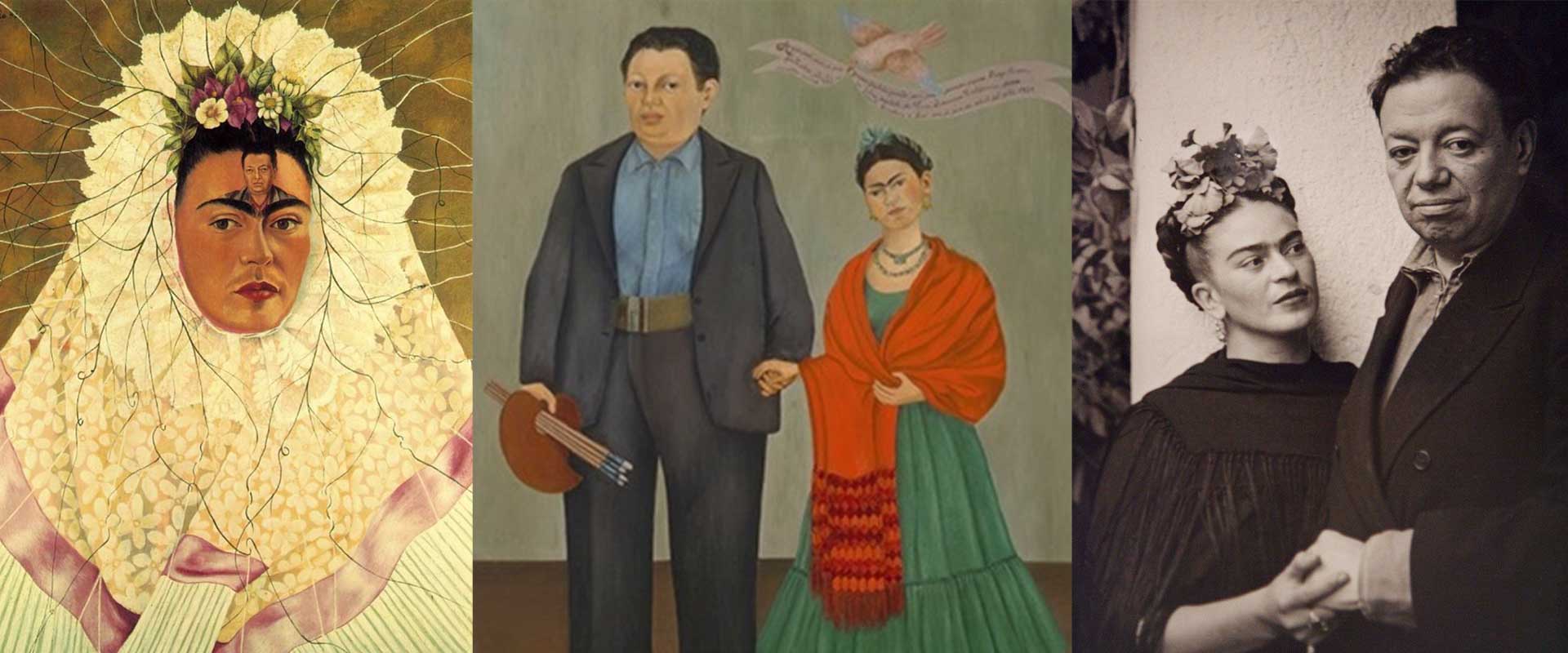How Diego Rivera influenced Frida Kahlo’s work (and vice versa) is one of the most fascinating dynamics in art history. While each had a unique artistic voice — Rivera’s rooted in monumental murals and political narratives, Kahlo’s in deeply personal symbolism and surrealism — their creative exchange shaped both their careers. From the moment they met, their relationship was more than romantic; it was a profound meeting of artistic minds. Visitors to the Frida Kahlo Museum and admirers of Frida Kahlo wall art prints can see traces of each other’s influence woven through their works.
No products found.
When Frida Met Diego
Frida Kahlo first approached Diego Rivera in 1928 to seek an opinion on her paintings. Already one of Mexico’s most famous muralists, Rivera was struck by her boldness and raw talent. He encouraged her to pursue her own vision rather than imitate European styles, a piece of advice that became central to her development as an artist.
Rivera’s Influence on Kahlo
Rivera’s guidance went beyond technical critique — he urged Kahlo to draw inspiration from Mexico’s indigenous culture, folk art, and political struggles. This direction reinforced her commitment to the Mexicanidad movement, which celebrated national heritage after the Revolution.
Key Ways Rivera Influenced Kahlo’s Work
| Influence | Description | Example in Kahlo’s Art |
|---|---|---|
| Cultural Themes | Emphasis on indigenous heritage and pre-Columbian symbols | The Love Embrace of the Universe |
| Political Awareness | Infusing political narratives into visual art | Marxism Will Give Health to the Sick |
| Technical Advice | Encouraged bold color palettes and large-scale compositions | Self-Portrait on the Borderline Between Mexico and the United States |
| Artistic Confidence | Reinforced her unique voice and autobiographical style | The Two Fridas |
Kahlo’s Influence on Rivera
While Rivera was a seasoned artist by the time they met, Kahlo influenced him in subtler, yet equally profound ways. Her deeply personal approach to painting challenged his focus on grand narratives, encouraging him to consider the emotional and symbolic dimensions of art.
Key Ways Kahlo Influenced Rivera’s Work
| Influence | Description | Example in Rivera’s Art |
|---|---|---|
| Emotional Depth | Encouraged the inclusion of intimate, personal elements | Portraits of Kahlo in his murals |
| Symbolism | Inspired more layered imagery beyond political realism | Incorporating floral and domestic motifs |
| Perspective on Identity | Deepened exploration of Mexican identity through personal stories | Mural sections depicting daily life |
| Representation of Women | Portrayed women with greater complexity and individuality | Kahlo’s recurring presence as muse |
Artistic Dialogue Through Life Events
Their shared experiences — political activism, travel, and personal turmoil — fed directly into their work. When they traveled to the United States, Kahlo absorbed industrial landscapes into her paintings, while Rivera incorporated critiques of capitalism into his murals. Their mutual exposure to new environments expanded both their artistic vocabularies.
Politics as Shared Canvas
Both were committed Communists, and their art often reflected revolutionary ideals. Rivera’s public murals celebrated the working class, while Kahlo’s more intimate pieces addressed the struggles of ordinary people and the injustices of imperialism. Together, they blurred the line between personal expression and political statement.
Differences That Strengthened Their Art
Despite their influence on each other, Kahlo and Rivera maintained distinct artistic identities. Kahlo’s art remained deeply autobiographical, while Rivera’s addressed broader social narratives. This difference allowed each to contribute perspectives the other might not have explored on their own.
Shared Subjects and Mutual Inspiration
Kahlo appeared in Rivera’s murals, often as a symbol of Mexican womanhood, while Rivera appeared in Kahlo’s self-portraits, sometimes affectionately, sometimes critically. Their depictions of each other form a visual record of their evolving relationship — a blend of admiration, critique, and mutual dependency.
Conclusion
How Diego Rivera influenced Frida Kahlo’s work (and vice versa) is a story of mutual inspiration, artistic challenge, and shared cultural purpose. Rivera’s encouragement helped Kahlo embrace her identity as a Mexican artist, while Kahlo’s emotional depth and symbolic vision enriched Rivera’s murals. Together, they shaped a legacy that continues to inspire artists worldwide. Whether seen in the vibrant halls of the Frida Kahlo Museum or through Frida Kahlo wall art prints, their intertwined works remind us that great art often grows from great relationships — complex, challenging, and transformative.
FAQs About Their Artistic Influence
Did Rivera teach Kahlo to paint?
No, Kahlo was self-taught, but Rivera provided valuable critique and encouragement that shaped her artistic direction.
Did Kahlo appear in Rivera’s murals?
Yes, Rivera frequently painted Kahlo into his murals as a symbol of Mexican identity and beauty.
Did they share political themes in their art?
Yes, both integrated revolutionary ideals and critiques of imperialism into their work, though in different styles.
Can their mutual influence be seen in specific works?
Absolutely — Rivera’s murals and Kahlo’s portraits often reference each other visually and symbolically.
Where can I see their works together?
The Frida Kahlo Museum showcases her art alongside archival materials, and Rivera’s murals can be found in Mexico City and beyond.





